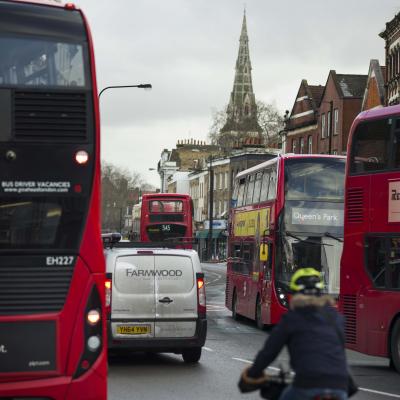How transport offers a route to better health
How transport offers a route to better health
25 February 2021

Key points
- This long read examines the challenges of shifting towards a transport system that better supports health. It sets out how transport affects health, the difficulties in moving towards greater use of public transport and the effects of COVID-19 on travel patterns.
- There have been huge changes to how we travel over the last 70 years. The average annual distance people in Britain travel is now three times as far as it was in 1952, largely due to a tenfold increase in the distance travelled by car. Over the same period, the average distance travelled by bus annually has decreased from 1,900km to 600km per person.
- Quality of transport infrastructure and adequacy of transport services directly affect health – for example, by enabling active modes of travel that have health benefits or reducing road accidents and harmful emissions.
- Our analysis suggests that increasing walking and cycling in all regions of England to that of regions with the furthest distance walked or cycled could prevent 1,189 deaths per year. If exercise levels increased each week by a combined 30 minutes of cycling and 30 minutes of walking, there would be an annual reduction of around 6,100 deaths.
- A transport system that is easily accessible, reliable and affordable contributes to life satisfaction and wellbeing in multiple ways. It enables access to work, friends and family, as well as health-supporting facilities such as schools, colleges, parks, libraries and health care centres.
- Research shows that people who rate public transport as ‘good’ are close to three times more likely than those who rate it as ‘poor’ to be able to access public services such as health care, food shops or education. They are also slightly less likely to report feeling under strain, being dissatisfied with life or experiencing mental health problems.
- Cars offer great convenience and mobility but can also reduce the mobility of others – by marginalising some road users and discouraging walking and/or cycling because of the way the built environment is designed to favour cars. The right planning approach can encourage a shift towards a wider range of transport options that can help support a healthier and more environmentally sustainable transport system.
- The investment required to support the UK’s recovery from the COVID-19 pandemic presents an opportunity to reshape our transport infrastructure and ‘level up’ access. It is essential that the government embeds these aims in new infrastructure projects, to increase safe cycling and walking facilities and to improve the availability, reliability and affordability of public transport services.
To explore our full analysis of how transport affects health, visit our What drives health inequalities? evidence hub.
Our analysis using the World Health Organisation’s HEAT tool (see box 1 for more detail) shows that increasing the amount of walking and cycling in all regions of England to that of regions with the highest distance walked or cycled for different age groups (up to age 74) could prevent 1,189 deaths per year. The majority of this improvement (around 80%) is from those aged 50 to 74. Given initially lower levels of cycling and walking, the regions with the greatest possible improvement in the rate of prevented deaths are the North East and the West Midlands. The greatest possible overall reduction in the number of deaths is in the South East, which is mainly due to the larger population in that region (Figure 2).
Figure 2
This scenario equates to a relatively small increase in minutes of exercise across the population as a whole. The same model estimates that if exercise levels increased each week by a combined 30 minutes of cycling for people aged 20 to 64 and 30 minutes of walking for people aged 20 to 74, there would be an annual reduction of around 6,100 deaths per year.
However, increasing the amount of active travel is not without its challenges. Using time to cycle or walk to work may displace time that was otherwise spent on other physical activity, or necessary day-to-day tasks for time-constrained families. And the option to walk or cycle to access employment or services may be restricted in rural areas, where the distances tend to be longer. These practical difficulties highlight the complex way in which transport systems affect how we live our lives.
Air and noise pollution
Road transport accounts for 35% of nitrogen oxide and 12% of particulate matter (also called particle air pollution) emitted into the air in the UK. These include PM10 particles (particles with a diameter of 10 micrometres or less) and PM2.5 particles (diameter 2.5 micrometres or less), both of which are small enough to penetrate the respiratory system. Outdoor air pollution is associated with premature mortality and increased risk of hospital admissions from respiratory disease, lung cancer and cardiovascular illness.
In the UK, long-term exposure to air pollution is attributed to between 28,000 and 36,000 deaths each year. Air pollution from road traffic tends to be worse in the most deprived areas, despite lower vehicle ownership rates in those areas, because more deprived areas tend to be more urban.
The health impacts of noise are well-documented too, with unwanted sound associated with higher levels of stress, anxiety, sleep deprivation, high blood pressure and cardiovascular disease, as well as cognitive impairment in children. The World Health Organisation has previously identified noise from transport as the second most significant environmental cause of ill health in Western Europe.
Road safety
Road collisions are clearly a major cause of preventable death, serious physical injury and psychological trauma. In 2019, road collisions in the UK caused around 153,000 casualties and killed 1,748 people. Car drivers and passengers accounted for the greatest number of casualties (43%) and fatalities (58%), which in large part reflects the fact that cars make up the majority of traffic. In comparison, there were 13 casualties in total who were bus and coach occupants in 2019.
Road safety standards have improved significantly in the past few decades, but vulnerable road users, such as pedestrians and cyclists, remain at a higher risk of serious injury or death than drivers. Collisions are also distributed unequally across society, with children and young adults in the most deprived areas experiencing a higher risk of injury and death than those in the least deprived areas.
Access to services and social participation
A transport system that is easily accessible, reliable and affordable contributes to life satisfaction and wellbeing in multiple ways. It enables access to work, friends and family, as well as health-supporting facilities, such as schools, colleges, parks, libraries and – more directly – health care centres.
The quality of a transport system captures a broad range of factors, including journey times and the availability of public transport, as well as the reliability and affordability of services.
Barriers to people using public transport vary geographically, and across demographic groups, but they all have the power to make it hard – or completely impossible – for people to access essential aspects of day-to-day life. This can contribute to stress, fatigue, low mood and social exclusion.
Research shows that people who rate public transport as ‘good’ are close to three times more likely than those who rate it as ‘poor’ to be able to access public services such as health care, food shops or education. They are also slightly less likely to report feeling under strain, being dissatisfied with life or experiencing mental health problems.
A similar study looking at the links between employment and the quality of the transport network shows that employment rates are negatively correlated with public transport travel times, even after controlling for car availability and socioeconomic variation. This suggests that more investment to improve transport services and reduce journey times could result in better employment opportunities.
If adequate public transport is not provided, this could widen social and economic inequality by limiting people’s opportunity to find employment and socialise with friends, as well as accessing public services (as discussed above). People in the most deprived areas are also at risk of health inequality caused by other transport-related problems, including higher exposure to air and noise pollution and more road collisions.
Poor transport can limit people’s opportunities to find employment and earn a stable income needed to support a healthy life. It can restrict access to high quality jobs and increase the risk of remaining unemployed for longer. And for those people who have insecure work with irregular hours, or low wages which do not justify the cost of commuting, it could also influence whether people stay employed or not.
Difficulties in shifting towards greater use of public transport
Our analysis shows that in 2018, around 18% of unemployed people and 6% of employed people in England either turned down a job or decided not to apply for a job due to problems with transport (Figure 4). For most of them, job location and unreliable public transport were the two most important factors. These pre-existing problems may exacerbate new difficulties in finding work, given how the severity of the current economic crisis differs between local areas and industrial sectors, as well as the need to socially distance on public transport.
Figure 4
Figure 5 shows that in most regions of England, 50–60% of people using private vehicles to commute believe it would be either ‘quite’ or ‘very’ difficult to switch to an alternative mode of transport. The one exception is London where only 34% of adults reported this. This conclusion is broadly consistent with other studies – for example, in 2019 more than half (57%) of drivers reported that they would use their cars less if public transport was improved.
Figure 5
Figure 6 looks at the transport difficulties experienced by people aged 17–59 in England who commute by public transport, cycling or walking. In 2018, around 33% experienced at least one difficulty. Of these, the most reported issue was transport quality (19% of commuters). Although varying a little over time, the extent to which people report difficulties with public or active transport has remained similar over time.
These problems may put people off using public transport in the first place. They can also have an impact on wellbeing and health because such difficulties with commuting can cause stress and anxiety.
Figure 6
The transport system affects health for different groups in different ways, meaning that different policy solutions are needed. As Figure 6 shows, quality is a problem for those already reliant on public or active transport. For lower income households, affordability and pollution pose particular issues.
To provide greater historic context, and an indication of future direction, the next section looks at changes in transport policy, before considering the impact of the COVID-19 pandemic on transport.
In part these trends reflect increased car use, but changes to bus policy also plays a role. The rise of bus use in London has been linked to policies introduced by Transport for London and the governance arrangements introduced at the turn of the century which have (for instance) allowed a standardised fare structure to be maintained, as well as economic and population growth and service quality.
Government funding is also important. By 2018/19, net support paid by local and central government for local bus services in London had more than tripled compared to 1995/96 levels, but only remained broadly flat in other metropolitan areas and increased by far less – 80% – in non-metropolitan areas. Since 2010/11, total net support had fallen by around 30% across all three types of area. With many bus routes run for a profit, reduced funding and usage can lead to a cycle of higher prices, further falls in usage and eventual closure of routes.
More recently, the Bus Service Act (2017) allowed metropolitan mayors to use franchising agreements in the same manner as Transport for London. In February 2020, the government launched a new 5-year plan with funding worth £3bn, to deliver more frequent bus services, affordable fares, bus priority measures and 4,000 zero-emission buses outside of London.
Rail network
As road transport increased from the 1950s, rail passenger numbers started to dwindle, and together with rising labour costs and frozen rail fares, these changes contributed to mounting financial losses for operators. Concerns about the level of subsidies needed to keep the network alive led to the Beeching report (1963), which recommended the closure of unprofitable stations. By the 1970s, the number of rail stations was reduced by almost two-thirds, but losses continued to accumulate.
British Rail was privatised in between 1994 and 1997: the track and infrastructure moved to Railtrack (now Network Rail), while service operations were franchised to private companies. Rail passenger numbers have increased significantly since then, in part due to more people commuting and travelling between major cities for work.
In more recent years there has been a focus on delivering large rail projects, such as HS2 and Crossrail, though both have had lengthy development periods, and the Great North Rail Project, which aims to improve rail across the north of England. There is also ongoing spend (£35bn between 2019 and 2024) to maintain the existing ageing rail infrastructure network.
Since the COVID-19 pandemic began, revenues have fallen due to much lower passenger numbers. As a result, the government abolished rail franchises in favour of emergency contracts and provided additional funding to train operators. The government have since announced above inflation rail fare rises, justifying these by the increased subsidy during the pandemic.
Walking and cycling
At the beginning of the post-war period, safety concerns discouraged policymakers from promoting cycling. The ever-rising demand for road space also meant that policies generally favoured the provision of infrastructure for driving. The early 1990s marked a shift in public attitudes, from focusing on the risks of collisions to acknowledging the physical activity and environmental benefits of active travel. These changes in public perception encouraged the government to aim to increase cycling rates.
Initiatives have included Cycle to Work schemes (a tax-free benefit, allowing employees to pay for commuter bikes in instalments via salary sacrifice) and the National Cycle Network, which provided 2,500 miles of cycling and walking routes in the 1990s. Despite these efforts, cycling has remained at around 0.5%–1% of total distance travelled since the 1970s.
In 2017, the government outlined an ambitious goal to double cycling rates and increase walking activity by 2025. Since then, around £1.2bn has been invested in English cities (not including London) to fund local infrastructure improvements, behaviour change incentives, safety measures and partnership building programmes. More recently, in February 2020, the government announced that a further £2bn will be invested over the next 5 years to overhaul bus and cycle links for every region outside London.
Green transport
The link between health and air pollution from transport was scientifically established in the 1950s, but widespread awareness was not seen until the 1970s. Concerns about air pollution from vehicles has since led to stricter emission regulations, including higher rates of road tax for more polluting vehicles. Over time, as newer vehicles with higher standards replace older ones, emissions from road transport have been trending downwards.
Congestion charging has been in place in one form or another in London since 2003, with the latest development the introduction of the Ultra Low Emission Zone (which requires a further daily charge for the most polluting vehicles). The creation of Clean Air Zones was announced in 2015 to effectively extend such charging outside of London. These are expected to be launched in Bath and Birmingham later this year.
In November 2020 the government announced that new petrol and diesel car and van sales would be banned by 2030. Around £1.9bn will be invested in electric vehicle charging infrastructure and consumer incentives to support drivers to make the transition. These plans are a key part of government plans to reach net zero emissions by 2050.
Further reading
Work with us
We look for talented and passionate individuals as everyone at the Health Foundation has an important role to play.
View current vacanciesThe Q community
Q is an initiative connecting people with improvement expertise across the UK.
Find out more

